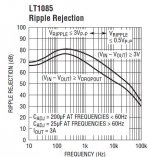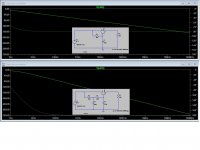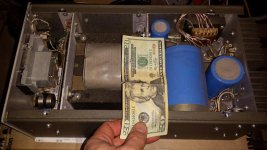I guess you mean this one.There's a passive filter project by Mark Johnson on this site
low noise split power supply
It’s not that I don’t want to expand on post SMPS passive filtering. It is only that we drift away from OP question.
There are plenty of passive filtering info on the web. This is representative
https://e2e.ti.com/blogs_/b/powerho...econd-stage-filter-for-sensitive-applications
One can try also a single common mode chock for HF conducted noise 🙂
George
i have a basket of refurbished and new smps 😱
If your smps is regulated and your schematic is not sensitive to voltage (example: in the range 10V to 15V is OK and not affected the performance), you can add capacitance multiplier after your smps. For small current you can drop around 2V. You must make your capacitance multiplier in the linear area (not saturated).
Hi ! thanks a lot for the very valuable links but ... i am sold on the active filter solution. Even if i have not seen psrr vs. Hz plots of cap multipliers i understand they can be very effective at high Hz.I guess you mean this one.
low noise split power supply
It’s not that I don’t want to expand on post SMPS passive filtering. It is only that we drift away from OP question.
There are plenty of passive filtering info on the web. This is representative
https://e2e.ti.com/blogs_/b/powerho...econd-stage-filter-for-sensitive-applications
One can try also a single common mode chock for HF conducted noise 🙂
George
For lower Hz the usual lm317 (or a lt1085) provide some 70dB of psrr ... more than enough i guess
I will be trying this solution with the cap multiplier before a IC regulation stage
I just hope that the CM is effective above 2kHz ? below that the IC will do its job (mains transformer > diodes bridge > cap multiplier > IC regulator )
Attachments
Last edited:
If you build one, take notice of the improvement in HF filtering properties of the cap multiplier you can have by simply using a 2nd order RC filter at the base of the transistor instead of the 1st order we usually see (same voltage drop on both scenarios)
George
George
Attachments
If you build one, take notice of the improvement in HF filtering properties of the cap multiplier you can have by simply using a 2nd order RC filter at the base of the transistor instead of the 1st order we usually see (same voltage drop on both scenarios)
George
Dear George i thank you sincerely. If i understand well the white lines are the psrr of the circuits vs. frequency ? how did you get those ?
Are these plots the outcome of a simulation ? which SW do you use ?
i will buy it immediately hoping that is not very difficult to use.
The second circuit performance is very impressive 😱
I feel like this is the most valuable advice i have received in all my time spent in the forum. I am sincere.
And i guess that the same circuit can be mirrored for the negative voltages as well to do a dual power supply ?
Thank you very much indeed. Please tell me the name of the SW.
I will buy it now.
Have a nice day 🙂
P.S.
impressive indeed. But considering that the parts are few and cheap i could even put two identical active stage in series like i have seen elsewhere Not that i need more psrr of this ... i am amazed by how simple circuits can tackle the noise in such efficient way Unbelievabletake notice of the improvement in HF filtering properties of the cap multiplier you can have by simply using a 2nd order RC filter at the base of the transistor instead of the 1st order we usually see (same voltage drop on both scenarios)
Last edited:
Thank you ! in two weeks i will be on holidays up to the end of the year
I will have time to dig into this wonderful SW I am very bad at math ... my second biggest regret 🙁
I love electronic design and it is all about math. 😱
I studied chemistry ... but i do not love it at all
Thank you so much again. I just hope to find the tip142 model 😀
1000 of hfe 😱 ... the ultimate cap multiplier

Have a nice day
gino
George, sorry to be repetitive but thank you very much indeed.
But now i am confused ... if performance so good can be obtained with quite basic designs why some designers ... i mean ... i have seen schematics with dozens of parts, passive and active ...
after a cap multiplier like the ones you posted just a simple voltage regulator should be more than enough
It could be like supplying the regulator with a virtual battery with zero noise
I am missing other things ? 😕
Zero noise, no.
Low noise, may be.
Be cautious on what you write when you enter the low noise design territory 😉
George
Low noise, may be.
Be cautious on what you write when you enter the low noise design territory 😉
George
If your "reference" book is more than about 2 years old, it's advice is obsolete. Maybe in the '317 days, not now.
The newest little chips are incredible, just like OP-Amps. Sure, in 1980 it was tenable to say discrete buffers were superior. Now, a $1.50 OP-Amp blows their doors off. Same with regulators. You do have to use them correctly, something I find not always the case in my recent research and looking inside some products I have just purchased.
I suspect many who think a power supply provides "dynamics" or any such nonsense needs to look at their distribution ( star preferable) and local bypass caps. Poor design with excessive source impedance, bypass ESR, insufficient reserve, etc. Nothing magic. Don't invent or implement a problem where it need not exist. A common problem is too small of a transformer.
The newest little chips are incredible, just like OP-Amps. Sure, in 1980 it was tenable to say discrete buffers were superior. Now, a $1.50 OP-Amp blows their doors off. Same with regulators. You do have to use them correctly, something I find not always the case in my recent research and looking inside some products I have just purchased.
I suspect many who think a power supply provides "dynamics" or any such nonsense needs to look at their distribution ( star preferable) and local bypass caps. Poor design with excessive source impedance, bypass ESR, insufficient reserve, etc. Nothing magic. Don't invent or implement a problem where it need not exist. A common problem is too small of a transformer.
If you build one, take notice of the improvement in HF filtering properties of the cap multiplier you can have by simply using a 2nd order RC filter at the base of the transistor instead of the 1st order we usually see (same voltage drop on both scenarios)
George
Very good information George, thanks for sharing!
If your "reference" book is more than about 2 years old, it's advice is obsolete. Maybe in the '317 days, not now. The newest little chips are incredible, just like OP-Amps. Sure, in 1980 it was tenable to say discrete buffers were superior.
Now, a $1.50 OP-Amp blows their doors off
Hi ! thanks a lot for the very helpful advice. I am from Piedmont too 😀
Piedmont - Discover Italy
literally it means at the foot (in italian "piede") of the mountain 🙂
I guess you refer to measurable performance of noise/THD ?
Good to know.
But for the moment i have decided to focus power supplies. I am playing with a cheap preamp. I do not know if i am hearing things but different psus sound indeed different
For instance with a laptop smps their is no dimension to the sound and with the volume at max i hear noise/hiss ...
With a LM317 based simple regulator and a refurbished EI transformer i like the sound quite better.
I have discovered the cap multiplier circuit lately 😱 and i am convinced about its validity. Even if it looks a very basic circuit it can get rid of most of the higher Hz noise elegantly

Very very interesting and thank you for the advice. If i am not wrong many new chip regulators are smd ? smd format is a show stopper for me.Same with regulators. You do have to use them correctly, something I find not always the case in my recent research and looking inside some products I have just purchased.
I suspect many who think a power supply provides "dynamics" or any such nonsense needs to look at their distribution ( star preferable) and local bypass caps.
Poor design with excessive source impedance, bypass ESR, insufficient reserve, etc. Nothing magic. Don't invent or implement a problem where it need not exist.
But looking at the basic LM317 datasheet i already see a 70dB psrr at low Hz with a decline at higher Hz.
If i block these higher Hz noise with a cap multiplier i guess i am done.
I am not looking for psrr of 100 dB ... even if the less the noise the better
A common problem is too small of a transformer
My method is simple ... i let the unit run ... after some hours i touch the transformer ... if it is hot it means to me that is under stress/undersized
Strangely transformers with very similar size heat up differently.
I tend to use EI transformers because i have noticed that lab bench linear power supplies use them instead of toroidals.
i understand they filter more the noise coming from the mains ? 🙄
Thanks a lot again,
gino
Attachments
Last edited:
So much still talking about last centuries regulators. I was referring to devices like TPS7A4701/3301 with a good 10dB more PSRR.
Yea, batteries are far from zero noise. Of course, regulators can be cascaded, nothing new there.
Yea, batteries are far from zero noise. Of course, regulators can be cascaded, nothing new there.
Not so fast dear Stubbie.
Not every one has to follow the “use the newest and best ICs”.
It seems we have a lot of older design component in our drawers which we mean to put in use for the pleasure of our hobby.
🙂
George
Not every one has to follow the “use the newest and best ICs”.
It seems we have a lot of older design component in our drawers which we mean to put in use for the pleasure of our hobby.
🙂
George
Not newest or best, new enough to meet the design goals, which the basis of this thread is saying the early chips do not do. So, going by the thread title, YES I am fine with IC regulators. Just pick one that meets the need instead of spending the effort and expense to force it to do what it can't. I have a bin full of 7812's too. Handy when I need power for a relay board or other non-critical use. Not where the notion of PSRR or noise is even a thought.
SO, whatever PSU you have built before the TPS7A4701/3301 arrival at your bench was/is to be thrown to the bin?
George
George
SO, whatever PSU you have built before the TPS7A4701/3301 arrival at your bench was/is to be thrown to the bin?
George
My friends call me bin ... please consider me for any scrapping 😱
Ginetto I will disappoint you on this. I am not planning to decommission anything due to advancement in technology.
I have given away some of my older audio gear and bulky components but that was not due to technology obsolescence.
I have yet to see experimental data by diyers of improvement at the output of DACs-preamplifiers from the use of the latest V regulator ICs.
Last week I received four TPS7A4701 modules that I had ordered more than a month ago (28Euro in total).
In the near future I will test them in some low level applications against the older technology designs, although I have to admit I don’t hold my breath on the outcome.
George
I have given away some of my older audio gear and bulky components but that was not due to technology obsolescence.
I have yet to see experimental data by diyers of improvement at the output of DACs-preamplifiers from the use of the latest V regulator ICs.
Last week I received four TPS7A4701 modules that I had ordered more than a month ago (28Euro in total).
In the near future I will test them in some low level applications against the older technology designs, although I have to admit I don’t hold my breath on the outcome.
George
Attachments
- Home
- Amplifiers
- Power Supplies
- Are you really fine with IC voltage regulators ?




